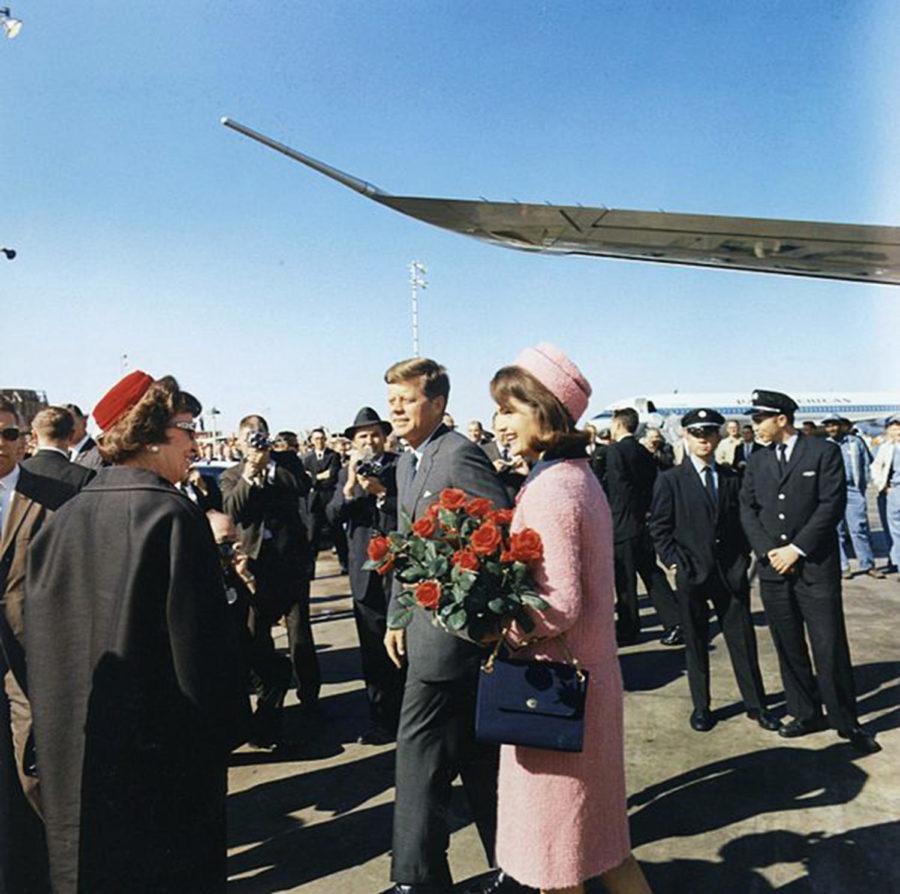Behind the bullet: 50 years of conspiracies surround JFK assassination
The 50-year anniversary of John F. Kennedy’s assassination on Nov. 22, 1963 is on Friday. Pictured are Kennedy and his wife, Jacqueline, shortly after arriving in Dallas the day of the assassination.
November 22, 2013
Unexpectedly bright, sunny skies — known as “Kennedy Weather” — broke out over Dallas on Nov. 22, 1963, exactly 50 years ago Friday. What would have been a normal stop for then-President John Kennedy, who was seeking re-election, instead ended in a tragedy that would remain ingrained in countless Americans’ memories.
What would come to be known as the “Camelot” administration, in reference to the president’s favorite musical, ended abruptly with the assassination of Kennedy and gave birth to five decades of conspiracy theories.
“Americans for whatever reason seem to love conspiracies,” said David Andersen, assistant professor of political science at Iowa State. “Americans love to believe that there’s something out there that is being hidden from us.”
The official conclusion of the Warren Commission, one of the first to investigate the murder, was that Lee Harvey Oswald acted as a lone sniper who shot Kennedy from a sixth-floor window of the Texas School Book Depository. The depository overlooks Dealey Plaza, which the president’s motorcade drove by on its parade route the day of the assassination.
Popular belief today, however, is that there was a wider conspiracy behind the death of the 35th president.
“How could this one demented, sick guy shoot down the most popular man in the country?” said Richard Reeves, author of “President Kennedy: Profile of Power” in an interview with the Daily. “I think it’s hard to accept that the things that you hold in admiration can be struck down for no reason by a nobody.”
Reeves and Andersen said they do not believe in a conspiracy themselves, but most polls find a majority of Americans do. The latest Gallup poll, for example, reports 61 percent of Americans believe Oswald did not act alone.
Although several investigations followed the assassination, they were short the key suspect. Oswald was shot by Jack Ruby, a nightclub owner, on Nov. 24, 1963, while being transferred from police headquarters to jail. He died shortly after.
The following are four of the most common conspiracy theories still speculated about today:
The Soviets
The Soviet Union and the United States were bitterly locked in the Cold War. Kennedy was president during the 1962 Cuban Missile Crisis, in which the two superpowers came close to starting a nuclear conflict. The USSR ended up agreeing to withdraw its missiles from Cuba.
“In order to believe the Soviet Union planned the assassination, you would also have to believe that the Soviet Union was willing to deal with the repercussions of assassinating the American president,” Andersen said.
The Cubans
Kennedy was president during the failed Bay of Pigs Invasion, in which Cuban exiles attempted to oust Fidel Castro, a Communist, and his government in 1961.
“The Cuban theories are the best because … the Kennedys were putting a lot of effort into trying to kill Castro, and obviously, Castro knew that,” Reeves said. “It was widely known that we wanted to get rid of Castro.”
Reeves said Oswald was involved with an organization called the Fair Play for Cuba Committee. This committee was opposed to the Bay of Pigs Invasion.
“It’s possible [Oswald] was influenced by all that, but that doesn’t make it a conspiracy,” Reeves said.
Lyndon Johnson
Lyndon Johnson, a Democrat from Texas, gave up a powerful seat in the U.S. Senate to run as Kennedy’s vice president. Kennedy and Johnson had competed for their party’s presidential nomination.
“Lyndon Johnson was known as a master of the Senate. He just controlled the Senate when he was in there. He understood power and how to use it, and he also understood when not to abuse it,” Andersen said.
Johnson also had many political enemies, Reeves said. This would have raised the risk of being discovered if he was behind the assassination.
Texas was a state that had many constituents opposed to what Kennedy believed in. Part of the rationale behind choosing Johnson as Kennedy’s running mate was to help gain votes from southern states.
“It’s very possible that the only way [Johnson] was going to get into the White House was to have Kennedy die,” Andersen said. “He would have been the next Benedict Arnold, a confirmed American traitor, and Johnson really cared about his image and his legacy.”
The CIA
The Central Intelligence Agency is rumored to have had many disagreements with Kennedy. They were also involved with the failed Bay of Pigs operation.
“I don’t doubt that the Warren Commission fudged some things to protect some people or secrets or perceptions,” Reeves said. “[But] those people are patriots, and patriots don’t kill presidents.”
Due in part to its secretive nature, the CIA has become a common target for conspiracy theorists.
Conclusion
There are many different versions of each of these theories, and the suspects behind the bullets range from Oswald to the Mafia.
The popularity of each one of the conspiracy theories tends to change over time, Andersen said.
“The fun thing with conspiracy theories is that you can never really disprove them,” Andersen said. “The lack of evidence just proves your theory.”
But some facts will remain unchanged with the test of time: On a day that Dallas was graced with “Kennedy weather,” a young president’s life was violently cut short in front of a shocked crowd, and the nation was left with much to speculate over.

















